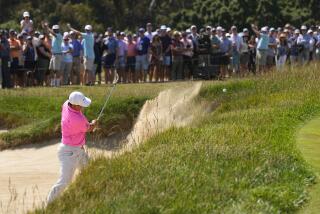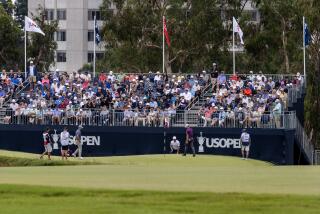U.S. OPEN : Shinnecock Just Isn’t Fair Game
- Share via
SOUTHAMPTON, N.Y. — There are many ways to check the degree of difficulty of a golf course. You can count the sand traps, check the wind flow, calibrate the topography, chart the doglegs.
In a U.S. Open, all you have to do is listen to the golfers.
When, to a man, they term a course fair, you read it easy. Under their breath, you can be sure they’re thinking, “I can birdie this sucker. Let me at it! Where’s the first tee?”
If they say, “Who in the world designed this layout--the Marquis de Sade?” you can be sure it’s fair. If they say, “What are they tryin’ to do--embarrass the finest players in the world?” or they moan, “Even God couldn’t reach these par fours,” you know they have met their match. The cut will be well over par.
American golfers, like Americans generally, are spoiled. They play all year on manicured, meticulously groomed, pool-table courses. Real estate developments, usually.
Then, they come to Shinnecock and it’s goodby to the good life.
The first duty of an Open golf course is not to separate the men from the boys but the men from the supermen, i.e., the players from the scramblers. The rough has to be high enough to hide a lion, the greens slick enough to skate on.
The trouble is, these penal institutions frequently fall on the wrong people. The young players with no idea of where they are, mistake it for a weekend round at Montalvo municipal. Like Little Red Riding Hood, they don’t notice grandma’s teeth and claws--so they ignore them.
That’s what leads to a Lee Mackey Jr. breaking the Open record with a 64 in the opening round at Merion in 1950. The next day, he noticed that was a wolf in the granny glasses--and shot an 81.
Nick Price, who has paid his dues and knows a wolf in any clothing, shot a tentative 66 in the first round at the Shinnecock U.S. Open Thursday. I say tentative because Nick announced before he played that he proposed to be “cautiously aggressive” in his approach to Shinnecock.
This oxymoronic approach netted him his 66 on a day few broke par and he did it by according the 100-year-old course the deference it deserved. Nick did not exactly attack the course, he infiltrated it. It was one of those scenes in which the course could mock “Nyah, nyah! You missed me!” And Nick could answer “Oh, yeah? Try to bend your knees!”
It’s difficult to categorize what Phil Mickelson is: a guy who doesn’t know what he’s up against or a guy who has been under enough pressure to know what to do about it when he’s overmatched.
It’s hard to tell with Mickelson. First of all, there are those big, innocent blue eyes, shambling walk, the pursed mouth that makes him look like a kid who just came down the stairs on Christmas morning.
For a golfer to come downstairs and be presented with Shinnecock is enough to make him want to shoot Santa Claus. Any course that is 7,000 yards long but par is 70 is public enemy No. 1, golf’s version of a serial killer. It doesn’t need much more help. Growing rough or speeding up the greens on this sociopath is like giving a bear an extra claw or a shark another tooth. It’s overkill.
Into this hall of horrors, young Master Mickelson marched. Strong men couldn’t bear to look. The Humane Society was ready to file a protest.
For one thing, Master Mickelson plays the game backward. Left-handed.
Now, it’s possible that nearly half of mankind is left-handed--but not that part of it found on golf courses. Golf courses, like most of the rest of the world, were designed for and by right-handers. Every Open has been won by a right-hander. In fact, the only “major” ever won by a lefty was the 1963 British Open by Bob Charles.
Phil was marching along, taking liberty after liberty with this treacherous piece of real estate Thursday, when he came up to the par-five 16th, a 544-yarder that isn’t supposed to be one of Shinnecock’s hell holes.
But it’s like the good-cop, bad-cop interrogation routine. Before you know it, No. 16 has you in handcuffs, wondering what you said or did wrong. You thought it was your friend. It bent young Master Mickelson’s hand back till it nearly broke as he tottered to a double-bogey seven. He was so shaken, he promptly bogeyed the next hole, the par-three 17th.
You had this terrible vision of Shinnecock shaking young Mickelson and shouting, “All right! ‘Fess up! You know you did it! Take him away and lock him up!”
You had the feeling Phil should have known better than to rattle Shinnecock’s cage. Should have tiptoed past it. He tried to smuggle a five-under-par into the clubhouse but Shinnecock would have none of it. It boxed the young whippersnapper’s ears.
Still, you could fit all the under-par shooters in a Volkswagen by day’s end, and, in the post-round interview, Mickelson correctly allowed that he should be happy with his two-under-par round.
“That will probably not be my last double bogey on this course,” he predicted. “And not the last double bogey made by anybody.”
Because of the unforgiving nature of Shinnecock, he said, “You can only go at about half the pins. The wind is unfriendly.”
The course is too. It’s impregnable. You can’t attack. You defend yourself against this course. It gets 18 shots at you.
“It alters your thought process,” Mickelson conceded. “Where on another course you might take a five-iron, here you take a seven-iron. You don’t challenge it. You stick to the possible.”
Phil is learning. He must outsmart, not outslug Shinnecock. Maybe he should wear a disguise.
Of course, in the old fight game, nobody wanted to fight a lefty. Too hard to figure. It would be irony if Shinnecock ended up the one confused and bloody. And Phil Mickelson ended up the most famous southpaw since Babe Ruth.
More to Read
Go beyond the scoreboard
Get the latest on L.A.'s teams in the daily Sports Report newsletter.
You may occasionally receive promotional content from the Los Angeles Times.










